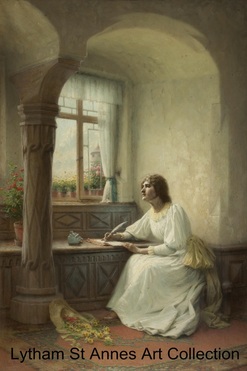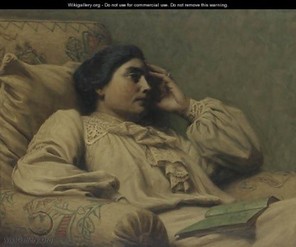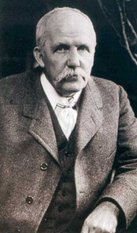Goodbye
|
Research by Marjorie Gregson
|
|
Acc No 48
Artist Arthur Cramer James Wasse Artist dates 1854-1930 Medium oil on canvas Size 121.9 x 86.4 cm (48 x 34 in) Date painted 1892 Inscr: Signed and dated 1892 Donor Alderman J H Dawson Date donated 24 December 1945 |
|
ARTIST
Arthur Cramer James Wasse was born in Manchester in 1854, the son of John Angelo Wasse, a painter of miniature portraits. He started painting at an early age. In 1875 Wasse was studying at the Manchester School of Art and, by the late 1870s, had exhibited work in London to good reviews. He received several prizes when he was studying at the Munich school of painting. After a short stint at the Royal Academy, Wasse returned to Munich, where he was entranced by southern Germany’s towns and landscapes and between 1875 and 1890 he travelled back and forth between Germany and England, running his own art school in London for a time. He married Mary McLeod Crowther in 1880 and they had a son, Frank. They were living in Rothenburg, Germany, when she died after the birth of their second son, Harry, in 1884. Once again he returned to England where he established a successful career, exhibiting at the Royal Academy with works including Bent Not Broken and Lancashire Pit Lasses at Work (this has appeared on the Antiques Road Show). Much of his earlier work depicted the poor working conditions of the Lancashire coal mines. Between 1891 and 1895 he exhibited paintings with nature themes and mythological scenes such as A Siren, Devotion and Poppies and Peonies. In 1895 he moved back to Rothenburg, residing at Klingentorbastei, a modest dwelling just outside the town walls. He had been enthralled by the town’s medieval shapes and shadows during previous stays there. Now married to Rebecca Fanny Pittar, born in Brighton in 1869, he remained in Rothenburg until his death in 1930. Perhaps depressed by the social conditions in England, he dedicated the rest of his professional life almost exclusively to Rothenburg. Several of his paintings captured the many moods and views of the town he enjoyed from home. 'Many depicted the town with a sombre sense of its past greatness; melancholy contrasted with thick, colourful vegetation which brought life into the scene but also suggested an advanced sense of decay'. He also painted portraits and there is a lovely study of his wife, Fanny. From 1916-1918, as an 'undesirable alien', he had to report to the police regularly in Rothenburg. Wilhelm Schacht vouched for Wasse, who retained his British citizenship but lived in Germany throughout the war, as a valued member of the community. He died and was buried in Rothenburg in 1930.
In 1940 Fanny Wasse gave the city 58 oil paintings on condition that they were displayed and that his grave was maintained. The Imperial City Museum in Rothenburg has a room devoted to his work and in 2004 there was a special exhibition entitled 'Arthur Wasse-Retrospective'; the occasion was the 150th anniversary of his birth. This allowed all his works, many of which had been deposited in recent years for reasons of conservation, to be seen again. When Fanny died in 1954 the city inherited the sum of 11,000 DM. Today, in Rothenburg, Wasse is a cherished painter who gained fame both nationally and internationally. There is a street named after him, Arthur-Wasse-Weg, such is the esteem in which he was, and still is, held. There is a painting of him as a young man, by Knupfer, in the Manchester Art Gallery. He exhibited at, amongst other venues, the Royal Society of British Artists, Suffolk Street London, Glasgow Institute, Walker Art Gallery Liverpool, Manchester City Art Gallery, Royal Academy of Art and in Paris (1910).
Other paintings include, A Courtyard in Bavaria, Afternoon Repose and A Continental Village in Winter. The artist, Annie Swynnerton (1844-1933), appointed the first woman Associate of the Royal Academy at the age of 77, was related through their grandfather, John Robinson. PAINTING The scene depicts a lone figure framed by the column on the left and the right of the arch. The light falls on her, illuminating her still figure and pensive face. The muted colours give a sense of melancholia. The painting is one that seeks to evoke an emotional response from the viewer. Is she phrasing the words she is about to commit to paper? To whom is she saying, 'Goodbye'? Do the flowers on the carpet hold any significance? Although the eye is drawn to her and her beautifully painted dress, the viewer sees the fine details in the picture; the garden with a dovecote through the curtained window, the frame of which is in the distinct shape of a cross, the discarded hat on the patterned carpet, the carving on the woodwork and the potted plant peeping from behind the column. |
REFERENCES
www.alt-rothenburg de/unser-engagement/gehaltene-vortraege Hagen, Joshua, Preservation, Tourism and Nationalism; The Jewel of the German Past www.findmypast.co.uk www.bbc.co.uk/yourpaintings REFERENCES |



